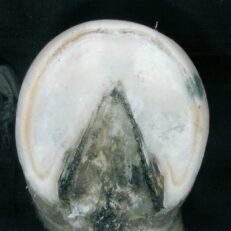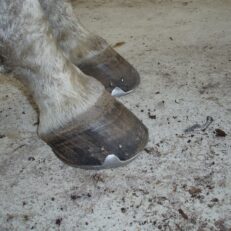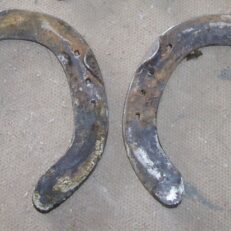When we alter the ground bearing shape of the hoof contrary to the shape of the normal coronary band, for any reason, we change the normal flight of the hoof.
This statement should be common sense to us, it certainly is for the horse, so why do we, who are entrusted with the duty of care to our horses, keep defying what nature is showing us?
There is only one correct way to dress the hoof to suit the horse so that it avoids discomfort and lameness; all you have to do is to see what you are looking at. The coronary band is (in most cases) a nice even shape; when you clean out the old crusty sole to where it meets the hoof wall, you will see that the white line/laminae shape (which is the true road map of the bottom of the hoof) is the same shape as the normal coronary band. (Pic 1) This is a great revelation, and should never be overlooked.
The hoof wall must be an even thickness all the way around. The centre point of balance in the bottom of the hoof is 19mm behind the active tip of the frog. When the hoof is correctly balanced you will have an equal measurement from that point to the toe and to the heel, and a correct parallel hoof/pastern angle. The hoof must be correctly balanced to achieve this even thickness of hoof wall, which in turn then copies the shape of the white line, which in turn is the same even shape as the coronary band. These three should always be the same shape – hoof wall, white line and coronary band. But the hoof wall is the only one over which we have any direct control.
If the coronary band is distorted, there are three possibilities. It has been distorted by injury and or deformity, by long term trimming and shoeing problems, or by short term trimming and shoeing problems. Now, how can trimming and shoeing problems affect the shape of the coronary band?
Next to my shoeing bays at home there is an ever increasing pile of distorted shaped horse shoes which have been removed from lame horses entering the barn. All these horses leave sound, with normal shaped hooves, either shod or unshod. And if shod, they are in machine made factory shoes, which have not been distorted to fit the hoof.
A shoe should be as light as is possible to allow the horse to move freely and do the job. However, so many are fitted with shoes that are far too heavy, and often squared in the toe and may also have quarter clips (Pics 2a and 2b). These shoes have crept into our market place over the past few years supposedly to suit the heavier warm blood types, but are far too heavy for most of our Australian horses.
Apart from the weight of the shoes, the squared toe alters the stride of the horse and the quarter clips severely restrict the expansion in the bottom of the hoof wall. They also have a nail pattern which is too close to either side of the clips and when used tends to jam that part of the hoof wall in behind the clips.
When removing this type of shoe I have noticed that the hoof is very sensitive in these quarter clipped areas and there is a noticeable distortion to the coronary band directly above them (Pic 3). The short term use of any distorted shoe shape may be desirable to counteract a hoof problem, however the long term use of such shoe shapes will cause the hoof to flare under pressure, and this will cause other problems such as cracks, hoof wall separation, abscesses, seedy toe, distortion of the lateral and medial cartilage and long term lameness.
And that’s just the fronts – the hind shoes are just as important and must be an even and symmetrical shape. So many horses are trimmed or shod and left standing with the toes pointing out or cow hocked – this causes weakness in the driving end and pain across the hips.
Once again, see what you are looking at: if the horse is standing cow-hocked the hoof will have a flare in the outside toe quarter. The inside heel will become crushed and under run and the outside heel will begin to flare out as well.
Some hind shoes are still made with the outside branch fuller than the inside branch and if we use this type of shoe we are in fact shoeing to the distortion instead of correcting it, so for the horses wellbeing correct the flares which will then allow the horse to stand straight, and then fit a balanced symmetrical shoe. It seems to be the trend also to use quarter clipped hind shoes (Pic 4) supposedly in case they screw when turning and shift a shoe.
These quarter clips inhibit hoof expansion and will eventually result in lameness. A shoe with a simple toe clip or no clip at all will not move on the hoof if it is correctly fitted to a well balanced hoof. So once again, these new trends are catering to poor shoeing practices and ultimately perpetuating the problems.
This is a bit like the chicken and the egg story – which came first? Have the horse shoe manufacturers made all these bandaid type shoes to cater for what they see are our needs, or have we the hoof carers and farriers allowed it to happen by not really seeing what the horse needs and by not insisting on using the correct shaped shoe which will enhance the horse’s performance, and not inhibit it.





